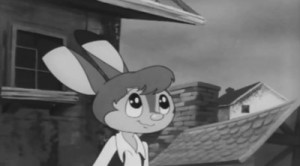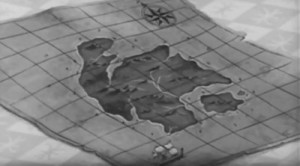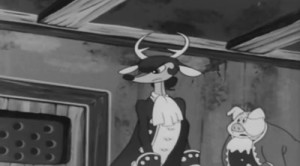New Treasure Island (Anime)
Also known as 新寳島 (Shin Takarajima)
The Black & White New Treasure Island (1965) TV Special aired on January 3, 1965 and was the first episode of Tezuka’s “Mushi Pro World” television series – Japan’s first 60-minute animated television program based on the same popular anthology format used by Walt Disney Company. Despite the title, the TV Special is not an animated adaptation of Tezuka’s New Treasure Island (1947) manga, but a largely literal retelling of Robert Louis Stevenson’s classic novel, Treasure Island – but with all the characters as animals.
What it’s about
Billy Bones, an old sea captain, comes to stay at the inn owned by young Jim Hawkins and his mother, and then dies from a seizure. Amongst his effects, Jim discovers a treasure map. With the help of Dr. Livesey and Squire Trelawney, they buy a ship and hire a crew, including a certain Long John Silver as a cook. When Jim overhears a conversation between Silver and some of the crew, he realizes they are pirates and after the very same treasure that he and his friends are seeking.
Once the ship reaches its destination, a fight breaks out with Silver and his pirates on one side and Jim’s friends and the non-pirate members of the crew on the other. After the pirates take control of the ship, they replace the Union Jack with the Jolly Roger skull and cross-bones. Of course, Jim and his friends eventually escape and make their way to the site marked on the treasure map – only to discover that a sailor from the original pirate crew has already found and moved it.
Since he has no need for the treasure while he’s stuck on a deserted island, he trades it for passage home. And so, Jim and his friends set sail for home, with some of the pirates prisoner and the rest left behind on the island.
What you should know
Although “Mushi Pro World” television series was originally envisioned as a showcase of Tezuka’s work, the first episode, New Treasure Island (1965) was chosen to be a retelling of Robert Louis Stevenson’s classic novel, Treasure Island, with animals – with Mii-chan, the scientifically-altered talking rabbit in Lost World (1948), cast as Jim, a wolf cast as Long John Silver, a pig as Trelawney, a stag as Dr. Livesey, etc. Although the exact reasons are unknown, it is possible that copyright issues with the publisher, or the fact that it was co-authored by Shichima Sakai, prevented the animation from being based on Tezuka’s debut classic manga, New Treasure Island (1947).
All in all, it is a children’s film, and very simple, with long periods of slapstick or other silly jokes. However, its position in the continuing evolution of Tezuka as an author is very interesting.
Though the story is not his, the film shows Tezuka’s artistic touch in three key ways. First, the animation throughout the film is very experimental, with unusual transitions, visual puns, and a fantastic rhythmic dance sequence performed by the sailors during the preparation and embarkation of the ship, which mark the film as one of the early experiments of one of the great pioneers of animation.
Second, the addition of a volcanic eruption on the island at the end makes the final conflict not a fight between good and evil, or a battle over treasure, but the struggle for survival, in which all characters, pirate and lawful, are given over completely to animal desperation. This way of reducing all conflicts to the universal battle of life vs. death is a characteristic of most of Tezuka’s more serious works, most notably Phoenix which he worked on almost continuously from 1954 to his death in 1989. Indeed, the volcano interrupting a war and reducing a greedy and corrupt civilization back to the harsher and more innocent level of mere survival is exactly the story seen in the initial sections of Phoenix, written a decade before this film.
Third, the animal characters are here used to explore the theme of transformation from civilized creature to beast, a major recurring subject in Tezuka’s work, which would have its major launching point in Vampires (1966-69), which began its run in 1966, the year after the completion of the New Treasure Island (1965) TV Special. When the pirates (all carnivores) are drunk or rowdy, they have trouble controlling their animal urges, displaying claws and fangs, and even losing the ability to speak, to stand on two legs, or to hold objects in their hands, which are reduced to paws. In the final flight from the volcano, the animals, good and evil, fall onto all fours, discard their human clothing as they flee, and their hands and feet are transformed to paws and hooves, so they escape with literally nothing except the animals within themselves. This film effectively shows an intermediate stage between the humans reduced to surviving on an animal level seen in early Phoenix (1968-88), and the Vampires (1966-69) who transform into beasts (voluntarily or involuntarily) in order to explore the inner amoral animal hidden within all humans.





